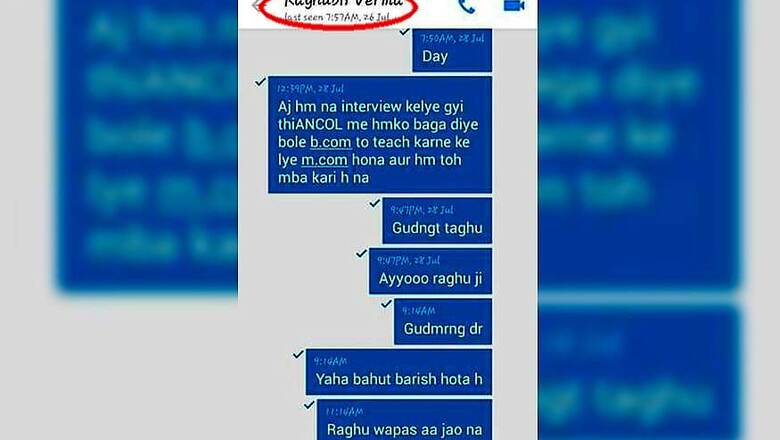
views
"I believe my son will be back," said Sunita Verma, the mother of missing 22-year old Raghuvir Verma who was on board the AN32 aircraft with 28 others which disappeared over the Bay of Bengal on 22 July, in a low voice sitting in her quarters in Port Blair right next to the airport.
Wife of a former police constable and mother to two sons of which Raghuvir was the younger, Sunita had a blank look on her face when I first visited the family four days after the plane went down. It was evening and the cramped looking living room was full of empathetic friends, relatives and neighbours.
"Her tears have dried up," one of them said, "she hasn’t stopped crying ever since heard about it on TV".
I was taken aback by her resolve when Sunita uttered those words looking straight at my eyes.
All I felt for her then, from an untouchable and safe distance of an observer of yet another tragedy in my journalistic career, was deep sympathy. But I am not so sure now.
Three days later and a week after the plane went missing, when Raghuvir’s family made the fantastic claim that they discovered his phone ringing till noon that day though no one picked it up, all I visualised was Sunita’s face which was desperate to cling to hope.
"It was she who first found out that the phone was ringing last evening. We did not pay much attention to her and thought it to be a rant of a depressed mind. But when we called that number which remained switched off since the plane disappeared, it was ringing. Miracles happen, don’t they?” said Lakhichand Verma, Raghuvir’s father.
What's even more baffling was the second claim which came from Shankar, Raghuvir’s friend back home.
"Here’s the screen shot of the mobile messaging App Raghuvir used and it shows that he last viewed his messages on the morning of 26th July. That's four days after the plane went down!" he said while holding out his phone in support of his claim.
"We have said all of this to the air force officials from the Andaman and Nicobar Command," informed Ranvir, Raghuvir’s brother, adding, "they have promised us that would get back with their probe findings within a day."
Raghuvir was stationed in Barmer, Rajasthan, his first posting after he completed his training in communications in the Indian Air Force two years ago.
"He was coming home on a holiday and asked me to receive him at the airport minutes before he boarded his flight from the Tambram air base in Chennai,” said Lakhichand, barely able to hide his emotions.
Meanwhile, one of the biggest search and rescue operations for the missing aircraft by the armed forces continues some 150 kilometres off the Chennai coast. The Indian Navy and its Coast Guard wing under the Eastern Command have deployed 16 ships which are scouring an area of 120 by 120 nautical miles of rough sea.
13 aircraft and four helicopters are searching an added area of 360 by 300 nautical miles of choppy waters amid strong south westerly monsoon winds.
The inclement weather, officials say, have only added to the challenges of this search operation in a region where the sea is over three and a half kilometres deep.
Vessels and aircrafts deployed by the Andaman and Nicobar Command are scanning the eastern flank of the flight route under the assumption that even if the plane may have disintegrated upon its collision with the water, strong ocean currents may drift some its debris towards the islands.
"It’s still a far cry. The debris may take weeks, if not months to travel this far," explained a senior officer at the Command headquarters in Port Blair.
And then there is, of course, the theory that the plane may have sunk to the bottom of the sea and flattened under the tremendous water pressure.
There are, however, more questions than answers surrounding the mystery of the missing AN32, considered to be one of the safest carrier-cum-cargo aircraft ever since it was inducted in service of the armed forces between 1984 and 1991.
The first, of course, is why did the Emergency Locator Beacon (ELBA) of the aircraft fail to work when it was most needed? The mechanism is designed to emit high frequency signals after a crash or a forceful impact.
Why did the fleet of vessels fail to pick the signal up despite them covering such a vast search area?
Secondly, even if the plane made a rapid descend from an altitude of around 23,000 feet where it flying before it went off the radar, why was there no 'May-Day' call from the pilot who should have had sufficient time to give that SOS signal if it had crashed the way it's believed to be?
After all both the pilot and co-pilot of the ill-fated plane were experienced professionals with over 1500 and 900 flying hours in their kitty respectively.
Thirdly, does India have the necessary cutting edge technology to tackle such critical situations where quick success could not only save valuable lives but also drag the collective conscience of a nation out of its anxious wait?
India seeking US help in this matter seven days after the incident certainly seems to suggest that it doesn't.
And till such time that elusive success is achieved, it’s the hope and resolve of mothers like Sunita Verma on which we would have to keep floating.
The Kala Pani of the Bay of Bengal will forever remain to haunt us otherwise.




















Comments
0 comment